《DSP using MATLAB》Problem 3.3
阿新 • • 發佈:2017-12-17
數學 直接 目的 end atl http radi class matlab

按照題目的意思需要利用DTFT的性質,得到序列的DTFT結果(公式表示),本人數學功底太差,就不寫了,直接用
書中的方法計算並畫圖。
代碼:
%% ------------------------------------------------------------------------ %% Output Info about this m-file fprintf(‘\n***********************************************************\n‘); fprintf(‘ <DSP using MATLAB> Problem 3.3 \n\n‘); banner(); %% ------------------------------------------------------------------------ % ---------------------------------- % x1(n) % ---------------------------------- n1_start = -3; n1_end = 13; n1 = [n1_start : n1_end]; x1 = (2 * 0.5.^ (n1)) .* stepseq(-2, n1_start, n1_end); figure(‘NumberTitle‘, ‘off‘, ‘Name‘, ‘Problem 3.3 x1(n)‘); set(gcf,‘Color‘,‘white‘); stem(n1, x1); xlabel(‘n‘); ylabel(‘x1‘); title(‘x1(n) sequence‘); grid on; M = 500; k = [-M:M]; % [-pi, pi] %k = [0:M]; % [0, pi] w = (pi/M) * k; [X1] = dtft(x1, n1, w); magX1 = abs(X1); angX1 = angle(X1); realX1 = real(X1); imagX1 = imag(X1); figure(‘NumberTitle‘, ‘off‘, ‘Name‘, ‘Problem 3.3 DTFT of x1(n)‘);; set(gcf,‘Color‘,‘white‘); subplot(2,1,1); plot(w/pi, magX1); grid on; title(‘Magnitude Part‘); xlabel(‘frequency in \pi units‘); ylabel(‘Magnitude‘); subplot(2,1,2); plot(w/pi, angX1); grid on; title(‘Angle Part‘); xlabel(‘frequency in \pi units‘); ylabel(‘Radians‘); X1_chk = 8*exp(j*2*w) + 4*exp(j*w) + 2 ./ (1-0.5*exp(-j*w)); magX1_chk = abs(X1_chk); angX1_chk = angle(X1_chk); realX1_chk = real(X1_chk); imagX1_chk = imag(X1_chk); figure(‘NumberTitle‘, ‘off‘, ‘Name‘, ‘Problem 3.3 X1(w) by formular‘);; set(gcf,‘Color‘,‘white‘); subplot(2,1,1); plot(w/pi, magX1_chk); grid on; title(‘Magnitude Part‘); xlabel(‘frequency in \pi units‘); ylabel(‘Magnitude‘); subplot(2,1,2); plot(w/pi, angX1_chk); grid on; title(‘Angle Part‘); xlabel(‘frequency in \pi units‘); ylabel(‘Radians‘); % ------------------------------------- % x2(n) % ------------------------------------- n2_start = -9; n2_end = 15; n2 = [n2_start : n2_end]; x2 = (0.6 .^ (abs(n2))) .* (stepseq(-10, n2_start, n2_end) - stepseq(11, n2_start, n2_end)); figure(‘NumberTitle‘, ‘off‘, ‘Name‘, ‘Problem 3.3 x2(n)‘); set(gcf,‘Color‘,‘white‘); stem(n2, x2); xlabel(‘n‘); ylabel(‘x2‘); title(‘x2(n) sequence‘); grid on; M = 500; k = [-M:M]; % [-pi, pi] %k = [0:M]; % [0, pi] w = (pi/M) * k; [X2] = dtft(x2, n2, w); magX2 = abs(X2); angX2 = angle(X2); realX2 = real(X2); imagX2 = imag(X2); figure(‘NumberTitle‘, ‘off‘, ‘Name‘, ‘Problem 3.3 DTFT of x2(n)‘);; set(gcf,‘Color‘,‘white‘); subplot(2,1,1); plot(w/pi, magX2); grid on; title(‘Magnitude Part‘); xlabel(‘frequency in \pi units‘); ylabel(‘Magnitude‘); subplot(2,1,2); plot(w/pi, angX2); grid on; title(‘Angle Part‘); xlabel(‘frequency in \pi units‘); ylabel(‘Radians‘); % ------------------------------------- % x3(n) % ------------------------------------- n3_start = -3; n3_end = 10; n3 = [n3_start : n3_end]; x3 = ( n3 .* (0.9 .^ (n3))) .* stepseq(-3, n3_start, n3_end); figure(‘NumberTitle‘, ‘off‘, ‘Name‘, ‘Problem 3.3 x3(n)‘); set(gcf,‘Color‘,‘white‘); stem(n3, x3); xlabel(‘n‘); ylabel(‘x3‘); title(‘x3(n) sequence‘); grid on; M = 500; k = [-M:M]; % [-pi, pi] %k = [0:M]; % [0, pi] w = (pi/M) * k; [X3] = dtft(x3, n3, w); magX3 = abs(X3); angX3 = angle(X3); realX3= real(X3); imagX3 = imag(X3); figure(‘NumberTitle‘, ‘off‘, ‘Name‘, ‘Problem 3.3 DTFT of x3(n)‘);; set(gcf,‘Color‘,‘white‘); subplot(2,1,1); plot(w/pi, magX3); grid on; title(‘Magnitude Part‘); xlabel(‘frequency in \pi units‘); ylabel(‘Magnitude‘); subplot(2,1,2); plot(w/pi, angX3); grid on; title(‘Angle Part‘); xlabel(‘frequency in \pi units‘); ylabel(‘Radians‘); % ------------------------------------- % x4(n) % ------------------------------------- n4_start = 0; n4_end = 50; n4 = [n4_start : n4_end]; x4 = (n4 + 3) .* (0.8 .^ (n4-1)) .* stepseq(2, n4_start, n4_end); figure(‘NumberTitle‘, ‘off‘, ‘Name‘, ‘Problem 3.3 x4(n)‘); set(gcf,‘Color‘,‘white‘); stem(n4, x4, ‘r‘, ‘filled‘); xlabel(‘n‘); ylabel(‘x4‘); title(‘x4(n) sequence‘); grid on; M = 500; k = [-M:M]; % [-pi, pi] %k = [0:M]; % [0, pi] w = (pi/M) * k; [X4] = dtft(x4, n4, w); magX4 = abs(X4); angX4 = angle(X4); realX4= real(X4); imagX4 = imag(X4); figure(‘NumberTitle‘, ‘off‘, ‘Name‘, ‘Problem 3.3 DTFT of x4(n)‘);; set(gcf,‘Color‘,‘white‘); subplot(2,1,1); plot(w/pi, magX4); grid on; title(‘Magnitude Part‘); xlabel(‘frequency in \pi units‘); ylabel(‘Magnitude‘); subplot(2,1,2); plot(w/pi, angX4); grid on; title(‘Angle Part‘); xlabel(‘frequency in \pi units‘); ylabel(‘Radians‘); % ------------------------------------- % x5(n) % ------------------------------------- n5_start = 0; n5_end = 30; n5 = [n5_start : n5_end]; x5 = 4 * (-7 .^ (n5)) .* cos(0.25*pi*n5) .* stepseq(0, n5_start, n5_end); figure(‘NumberTitle‘, ‘off‘, ‘Name‘, ‘Problem 3.3 x5(n)‘); set(gcf,‘Color‘,‘white‘); stem(n5, x5, ‘r‘, ‘filled‘); xlabel(‘n‘); ylabel(‘x5‘); title(‘x5(n) sequence‘); grid on; M = 500; k = [-M:M]; % [-pi, pi] %k = [0:M]; % [0, pi] w = (pi/M) * k; [X5] = dtft(x5, n5, w); magX5 = abs(X5); angX5 = angle(X5); realX5= real(X5); imagX5 = imag(X5); figure(‘NumberTitle‘, ‘off‘, ‘Name‘, ‘Problem 3.3 DTFT of x5(n)‘); set(gcf,‘Color‘,‘white‘); subplot(2,1,1); plot(w/pi, magX5); grid on; title(‘Magnitude Part‘); xlabel(‘frequency in \pi units‘); ylabel(‘Magnitude‘); subplot(2,1,2); plot(w/pi, angX5); grid on; title(‘Angle Part‘); xlabel(‘frequency in \pi units‘); ylabel(‘Radians‘);
運行結果:
1、原始序列及其DTFT
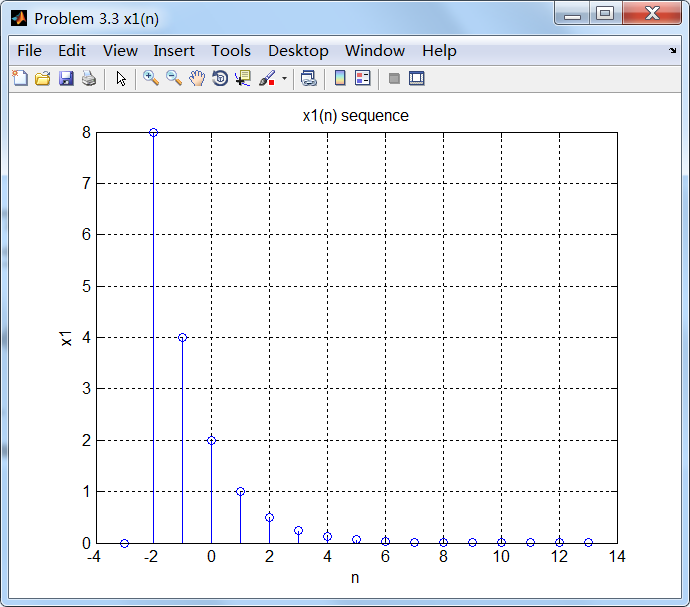
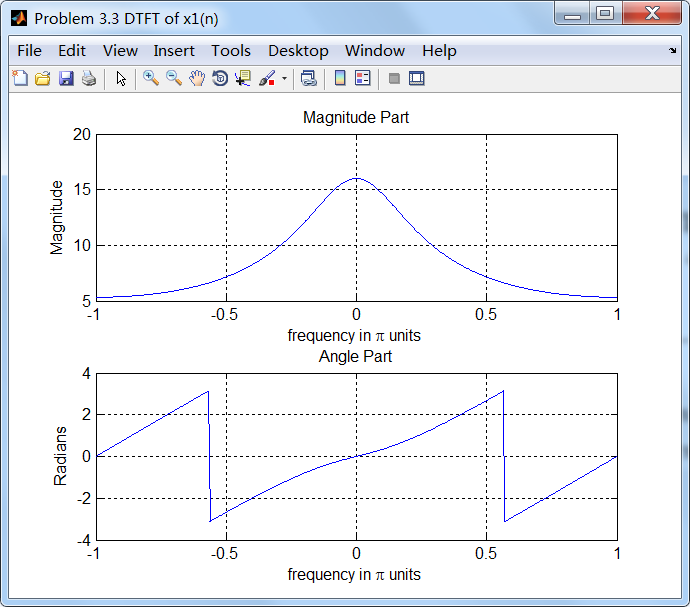
2、

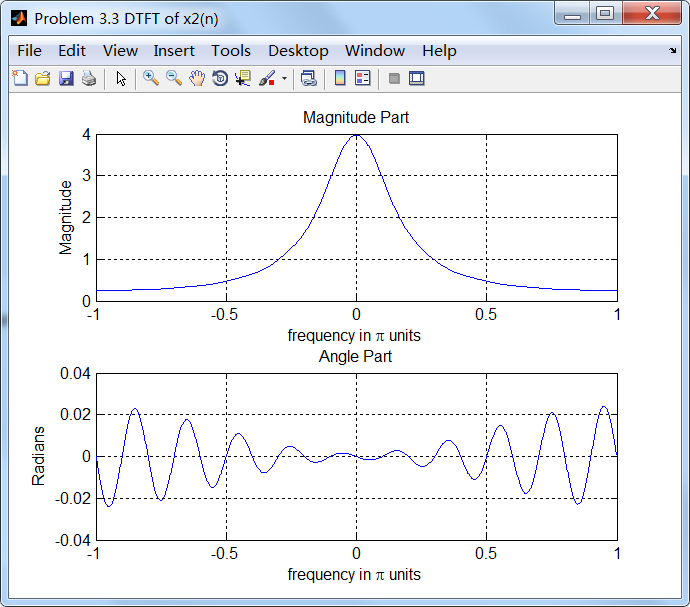
3、
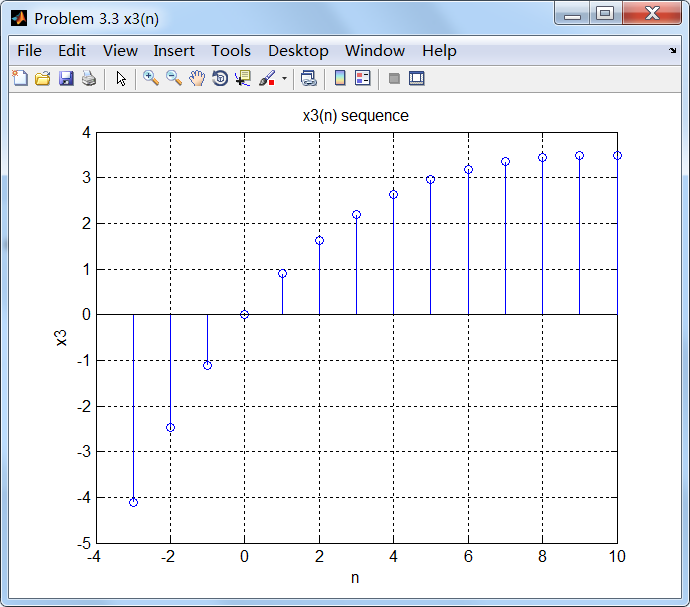

4、
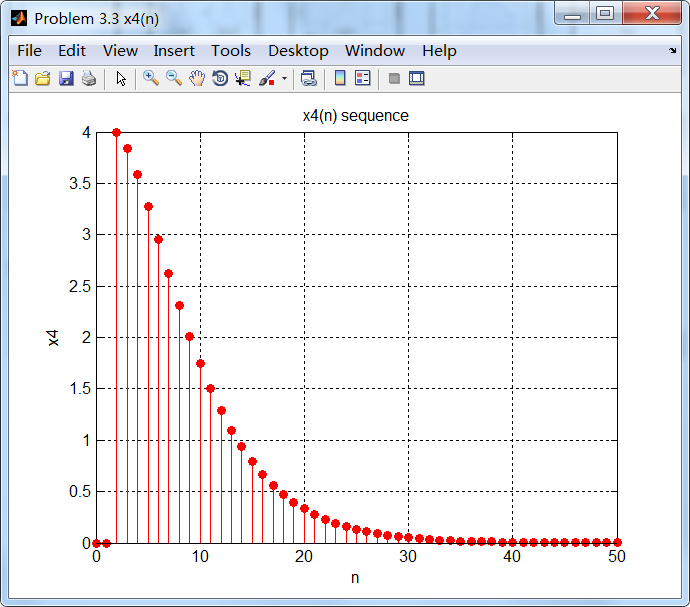
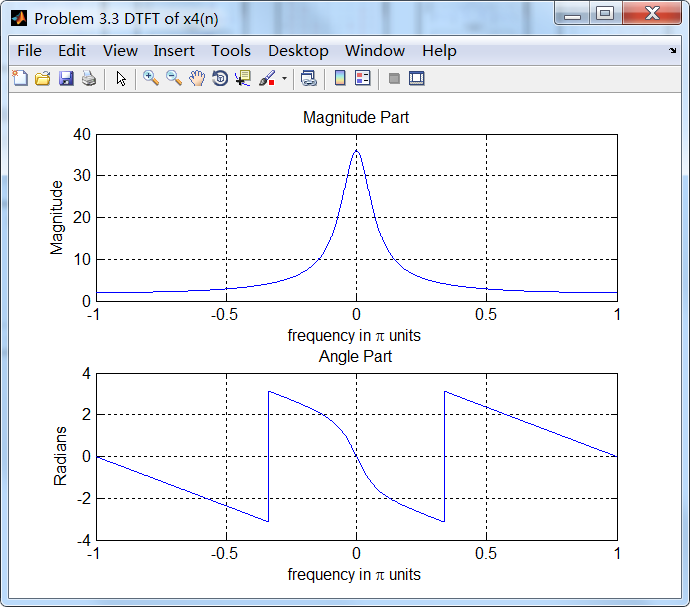
5、

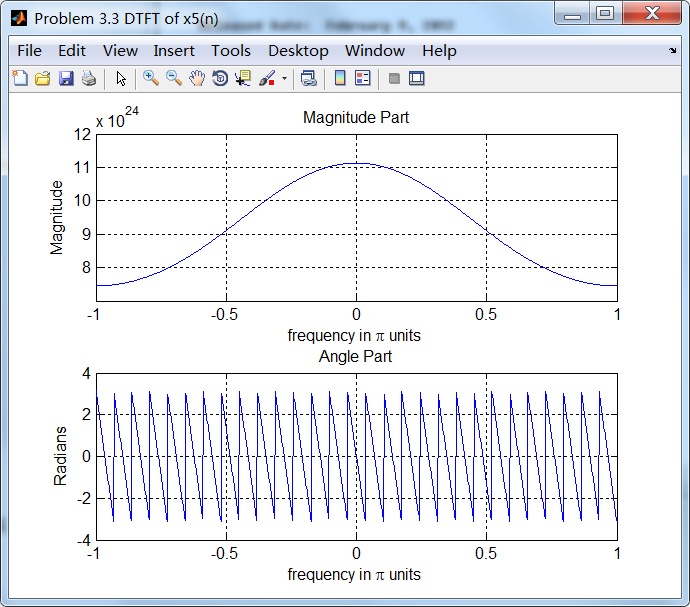
《DSP using MATLAB》Problem 3.3
